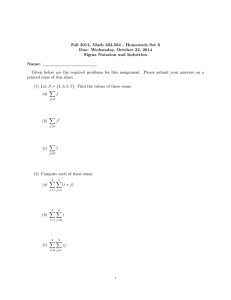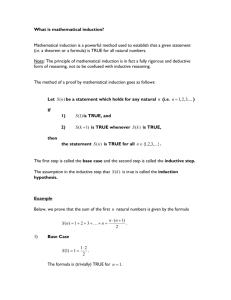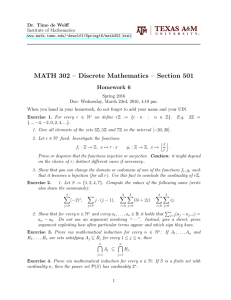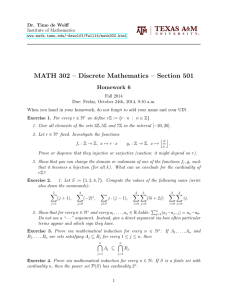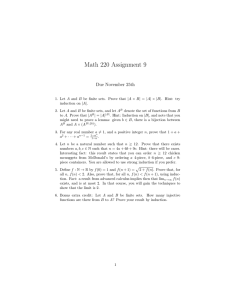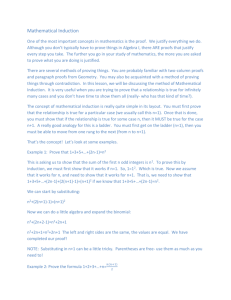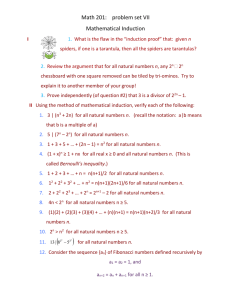Math 120 Notes on Mathematical Induction
advertisement
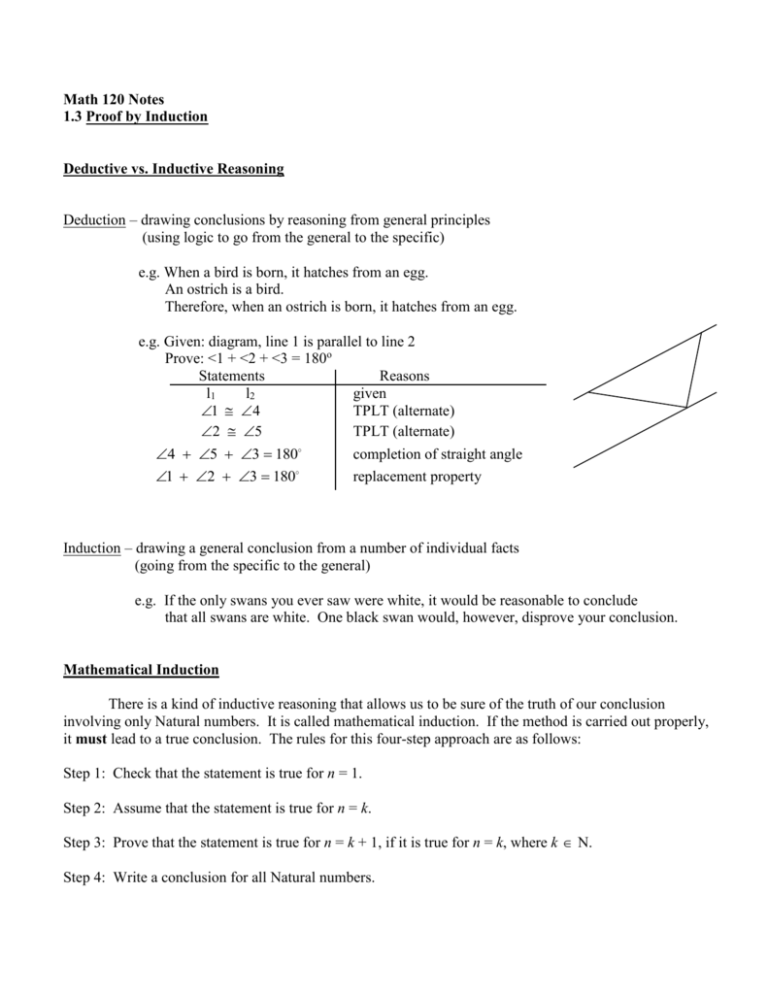
Math 120 Notes 1.3 Proof by Induction Deductive vs. Inductive Reasoning Deduction – drawing conclusions by reasoning from general principles (using logic to go from the general to the specific) e.g. When a bird is born, it hatches from an egg. An ostrich is a bird. Therefore, when an ostrich is born, it hatches from an egg. e.g. Given: diagram, line 1 is parallel to line 2 Prove: <1 + <2 + <3 = 180o Statements Reasons l1 l2 given 1 4 TPLT (alternate) 2 5 TPLT (alternate) completion of straight angle 4 5 3 180 replacement property 1 2 3 180 Induction – drawing a general conclusion from a number of individual facts (going from the specific to the general) e.g. If the only swans you ever saw were white, it would be reasonable to conclude that all swans are white. One black swan would, however, disprove your conclusion. Mathematical Induction There is a kind of inductive reasoning that allows us to be sure of the truth of our conclusion involving only Natural numbers. It is called mathematical induction. If the method is carried out properly, it must lead to a true conclusion. The rules for this four-step approach are as follows: Step 1: Check that the statement is true for n = 1. Step 2: Assume that the statement is true for n = k. Step 3: Prove that the statement is true for n = k + 1, if it is true for n = k, where k N. Step 4: Write a conclusion for all Natural numbers. Proving Summation Formulas 1 2 3 ... n 1. The Sum of the First n Natural numbers: n(n 1) 2 Step 1: Check that the statement is true for n = 1. L.S. = 1 R.S. = 1(1 1) 1(2) 1 2 2 L.S. = R.S. True for n =1. Step 2: Assume that the statement is true for n = k. Assume 1 2 3 ... k k (k 1) 2 Step 3: Prove that the statement is true for n = k + 1. L.S. 1 2 3 ... k (k 1) k (k 1) (k 1) 2 k (k 1) 2(k 1) 2 2 2 k 3k 2 2 (k 1)[(k 1) 1] 2 (k 1)(k 2) 2 2 k 3k 2 2 R.S. Step 4: Write a conclusion for all Natural numbers. 1 2 3 ... n n(n 1) ,n N 2 L.S. = R.S. True for n = k + 1. 2. The Sum of the Squares of the First n Natural Numbers: 12 22 32 ... n 2 n(n 1)(2n 1) 6 Step 1: Check that the statement is true for n = 1. L.S. = 12 1 R.S. = 1(1 1)[2(1) 1] 1(2)(3) 6 1 6 6 6 L.S. = R.S. True for n =1. Step 2: Assume that the statement is true for n = k. Assume 12 22 32 ... k 2 k (k 1)(2k 1) 6 Step 3: Prove that the statement is true for n = k + 1. L.S. 12 22 32 ... k 2 ( k 1) 2 k (k 1)(2k 1) (k 1) 2 6 k (k 1)(2k 1) 6(k 1) 2 6 6 2 2 k (2k 3k 1) 6(k 2k 1) 6 6 3 2 2 2k 3k k 6k 12k 6 6 3 2 2k 9k 13k 6 6 (k 1)[(k 1) 1][2(k 1) 1] 6 (k 1)(k 2)(2k 3) 6 2 (k 3k 2)(2k 3) 6 3 2 2k 3k 6k 2 9k 4k 6 6 3 2 2k 9k 13k 6 6 R.S. L.S. = R.S. True for n = k + 1. Step 4: Write a conclusion for all Natural numbers. 12 22 32 ... n 2 n(n 1)(2n 1) ,n N 6 3. The Sum of the Cubes of the first n Natural Numbers: n(n 1) 1 2 3 ... n 2 3 3 3 2 3 Step 1: Check that the statement is true for n = 1. L.S. = R.S. = Step 2: Assume that the statement is true for n = k. Assume Step 3: Prove that the statement is true for n = k + 1. Step 4: Write a conclusion for all Natural numbers. The previous three proofs may be summarized using sigma notation. n(n 1) j 2 j 1 n n(n 1)(2n 1) j 6 j 1 n 2 n j 1 n(n 1) j 2 3 2

